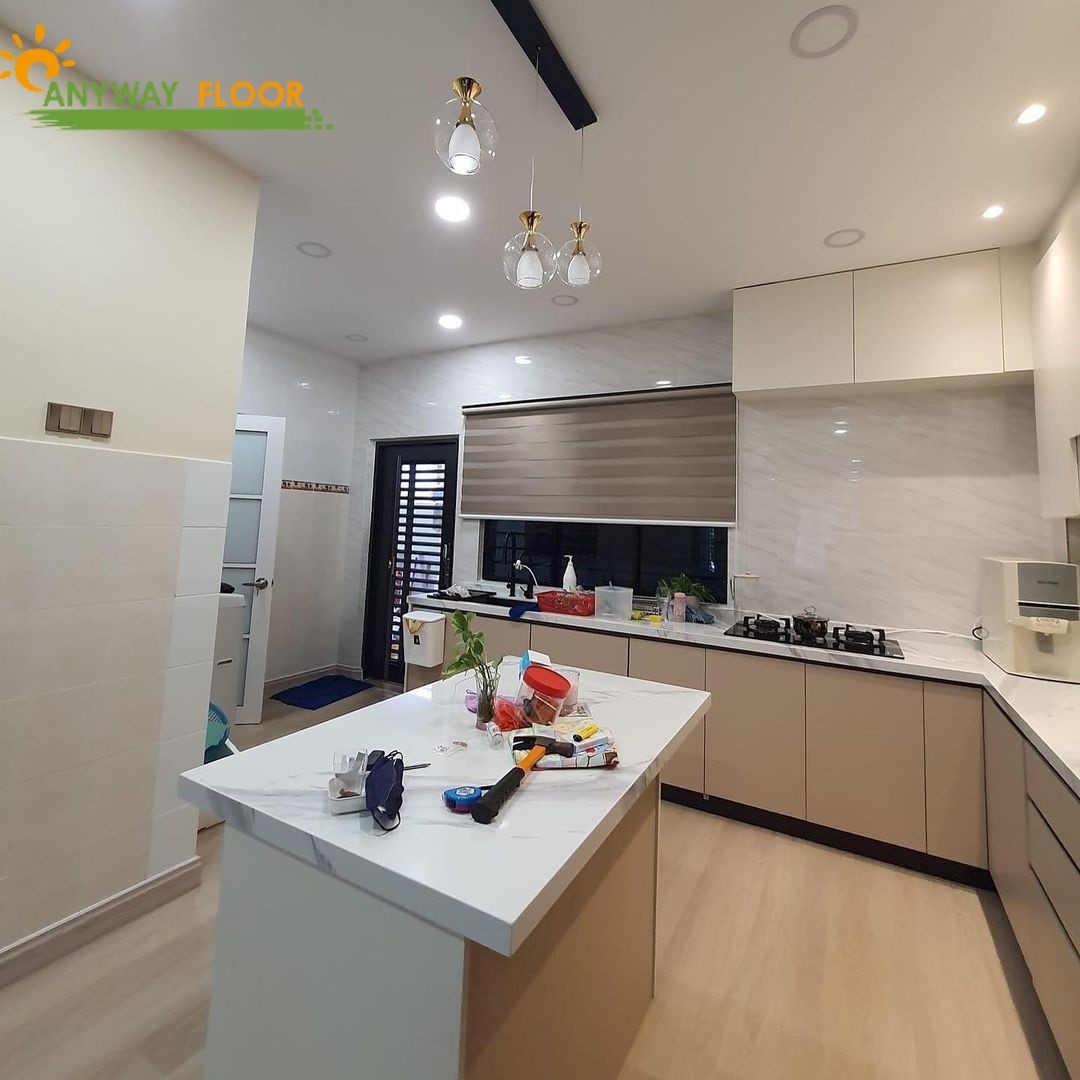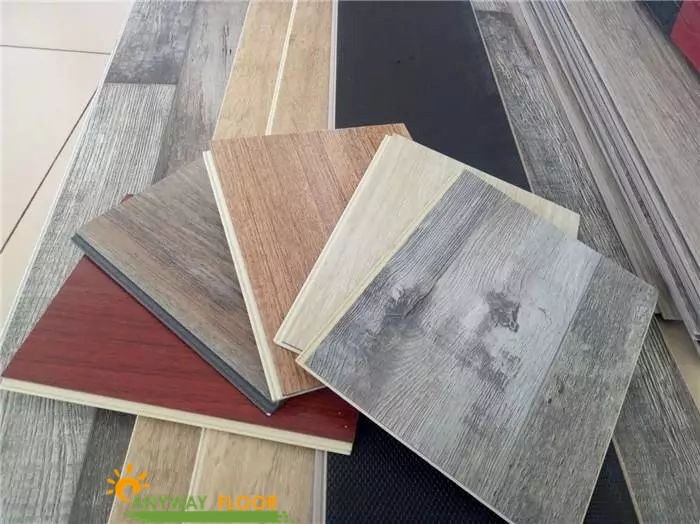
The Advantages of SPC Flooring over Traditional Hardwood and Laminate Flooring
There are various interpretations of what SPC stands for: S stands for solid or stone P stands for plastic or polymer, and C stands for composite or core. But ultimately, it is very similar to a vinyl component. It consists of a key ingredient of calcium carbonate on the inner core which is limestone. It is very dense and solid because of the minimal air component which makes the product very rigid. This rigidity is essential because you can mill in your joint structures. You can click and install SPC flooring similarly to a laminate floor. It can bridge slight undulations in the substrate so you don’t behave to be as pedantic as you would with vinyl and traditional vinyl products. SPC Flooring has become increasingly popular in recent years due to its numerous benefits over traditional hardwood and laminate flooring. In this article, we will explore the advantages of SPC flooring over traditional hardwood and laminate flooring.
Comparison in Durability
One of the key advantages of SPC flooring over traditional hardwood and laminate flooring is its durability. SPC flooring is highly resistant to scratches, dents, and stains, which makes it ideal for high-traffic areas such as commercial spaces, offices, and homes with pets and children. The durability of SPC flooring is due to its unique construction. SPC flooring is made of a combination of limestone and polyvinyl chloride (PVC), which makes it highly resistant to wear and tear. The limestone provides the SPC flooring with a hard and dense core that can withstand heavy foot traffic, while the PVC layer provides a protective coating that makes it highly resistant to scratches and stains.
Traditional hardwood flooring, on the other hand, is susceptible to scratches, dents, and water damage. This is because hardwood flooring is made of natural wood, which is a relatively soft material. Hardwood floors require regular maintenance, such as sanding and refinishing, to maintain their appearance and durability. Even with regular maintenance, hardwood floors may need to be replaced every 10 to 15 years due to wear and tear.


Laminate flooring, which is made of a thin layer of printed paper or film on top of a core of high-density fiberboard (HDF), is also susceptible to scratches and dents. While laminate flooring is more durable than hardwood flooring, it is still not as durable as SPC flooring. Laminate flooring is also prone to swelling and warping when exposed to water, which makes it unsuitable for areas such as kitchens and bathrooms.
The durability of SPC flooring makes it a sustainable and eco-friendly option. SPC flooring is made of natural materials, such as limestone and PVC, which are abundant and renewable. SPC flooring also does not contain harmful chemicals, such as formaldehyde, which is commonly found in traditional hardwood and laminate floors. Formaldehyde is a known carcinogen that can cause respiratory problems and other health issues. This makes SPC flooring a safer and more sustainable option for homeowners and businesses.
Comparison in Resistance to Moisture
Another advantage of SPC flooring over traditional hardwood and laminate flooring is its resistance to moisture. SPC flooring is highly moisture-resistant, which makes it ideal for areas prone to moisture such as bathrooms, kitchens, and basements. The limestone core of SPC flooring provides a waterproof barrier that prevents water from seeping into the floor, which means that it will not swell, buckle, or warp when exposed to moisture.
Traditional hardwood and laminate floors are not moisture-resistant and are susceptible to damage when exposed to water. Hardwood floors can warp and buckle when exposed to excessive moisture, while laminate floors can swell and buckle when exposed to even small amounts of water. This makes SPC flooring a more practical and cost-effective option for homeowners and businesses in areas with high levels of moisture.
Comparison in Installation
Another advantage of SPC flooring over traditional hardwood and laminate flooring is its ease of installation. SPC flooring is designed to be installed quickly and easily, which makes it a popular choice for DIY homeowners and professional installers. The installation process for SPC flooring involves a "click and lock" mechanism, which means that the planks can be easily clicked together without the need for nails or adhesives. This makes the installation process quick and easy, which saves homeowners and businesses time and money.
Traditional hardwood flooring, on the other hand, requires a more complex installation process that involves nailing or gluing the planks to a subfloor. This requires specialized tools and expertise, which can increase the cost of installation. Additionally, hardwood flooring requires acclimation to the environment, which means that the planks need to be left in the room for a period of time before installation to adjust to the temperature and humidity of the room.
Laminate flooring is also relatively easy to install, but it requires a more complex installation process than SPC flooring. Laminate flooring requires a subfloor, which can increase the cost of installation. Additionally, laminate flooring requires an underlayment, which is a layer of foam that is placed between the subfloor and the laminate flooring. This adds another layer of complexity to the installation process and increases the cost of installation.
Comparison in Design
In addition to its durability and easy installation, SPC flooring also offers a wide variety of design options that are superior to traditional hardwood and laminate flooring. One of the most notable advantages of SPC flooring design is that it can mimic the look and feel of hardwood flooring, but with added benefits. SPC flooring comes in a range of colors and textures that are designed to replicate the look of real hardwood, including oak, maple, cherry, and other popular species. However, SPC flooring has the added benefit of being more resistant to moisture, stains, and scratches than traditional hardwood flooring, which can make it a more practical choice for high-traffic areas of the home or business.
An added benefit of SPC flooring design is that it can replicate the look and feel of natural stone, such as slate or marble. This can give homeowners and businesses the appearance of high-end stone flooring, without the high cost or maintenance requirements of real stone. SPC flooring can also be designed to replicate the look of other popular flooring materials, such as ceramic tile or concrete.


In terms of design flexibility, SPC flooring offers more options than traditional hardwood and laminate flooring. SPC flooring can be cut and installed in a variety of patterns and configurations, which can create unique and custom looks. SPC flooring can also be installed with borders, inlays, and other decorative elements, which can add a personal touch to the design. SPC flooring offers more design options in terms of width and plank size. Traditional hardwood flooring typically comes in fixed widths and lengths, which can limit design options. SPC flooring, on the other hand, comes in a variety of widths and lengths, which allows for more design flexibility.
Comparison in Eco-friendly
SPC flooring is a type of vinyl flooring that is becoming increasingly popular as a flooring option. Here are some advantages of SPC flooring being eco-friendly over traditional hardwood and laminate. SPC flooring is made from natural materials such as limestone, polyvinyl chloride, and stabilizers. These materials are abundant and can be recycled, making SPC flooring a sustainable option compared to traditional hardwood and laminate. Also, SPC flooring is produced with low volatile organic compounds (VOCs), which means it emits fewer harmful chemicals into the air. This is better for both the environment and human health.
SPC flooring requires less energy to produce than traditional hardwood flooring. This is because the manufacturing process for SPC flooring does not require the same amount of water and energy as hardwood flooring. SPC flooring is recyclable and can be reused in other products. This makes it an eco-friendly option as it reduces waste and promotes sustainability. Overall, SPC flooring offers several eco-friendly advantages over traditional hardwood and laminate flooring, including being made from natural materials, low VOC emissions, energy-efficient production and recyclability.
Comparison in Cost
SPC flooring is generally less expensive than traditional hardwood flooring. This makes it a more affordable option for homeowners who want a similar look and feel to hardwood flooring without the high cost. SPC flooring is easy to install, with a click-lock system that allows for a quick and hassle-free installation process. This can reduce the cost of installation, making SPC flooring a more affordable option.
SPC flooring requires very little maintenance. Regular sweeping and mopping are all that is needed to keep the floor looking clean and new. Unlike hardwood, SPC flooring does not require sanding, staining, or sealing, which can be expensive and time-consuming. It is highly durable and can withstand heavy foot traffic, making it a long-lasting flooring option. This can reduce the need for frequent replacement, which can be both expensive and time-consuming. SPC available in a wide range of styles and colors, allowing homeowners to choose a look that fits their taste and budget. This makes it an affordable option for homeowners who want to update their flooring without spending a lot of money.
Comparison in Slip-Resistance
SPC flooring has a high slip-resistance rating, making it a safer option for areas where water or spills may occur, such as bathrooms and kitchens. This is especially important for homes with children, elderly individuals, or pets. SPC has a textured surface that provides additional grip, reducing the risk of slips and falls. This is unlike traditional hardwood and laminate flooring, which can become slippery when wet.
SPC flooring is easy to clean, with a surface that can be wiped clean without leaving any residue. This means that spills can be quickly and easily cleaned up, reducing the risk of slips and falls. High durability and lasting SPC flooring means that the slip-resistance properties of SPC flooring will remain intact over time. The versatile and wide range colors SPC flooring makes it an attractive option for those who want slip-resistant flooring that is also aesthetically pleasing. The surface of SPC flooring is textured, which provides added grip and reduces the risk of slips and falls. Traditional hardwood and laminate floors can be slippery, especially when wet, which makes them a safety hazard in commercial settings.
In conclusion, SPC flooring offers numerous advantages over traditional hardwood and laminate flooring. It is highly durable, moisture-resistant, easy to install and maintain versatile, eco-friendly, and budget friendly.
English
Русский
العربية
Français
Español
Português
Deutsch
italiano
日本語
한국어
Nederlands
Tiếng Việt
ไทย
Polski
Türkçe
አማርኛ
Bahasa Melayu
ဗမာစာ
Filipino
Bahasa Indonesia
magyar
Română
Čeština
Српски
हिन्दी
فارسی
Kiswahili
Slovenčina
Slovenščina
Norsk
Svenska
українська
Ελληνικά
Suomi
Հայերեն
עברית
Dansk
اردو
বাংলা
Hrvatski
Eesti keel
नेपाली
latviešu
Euskara
Български
Català
Hausa
íslenska
Lietuvių
Malti
isiZulu















